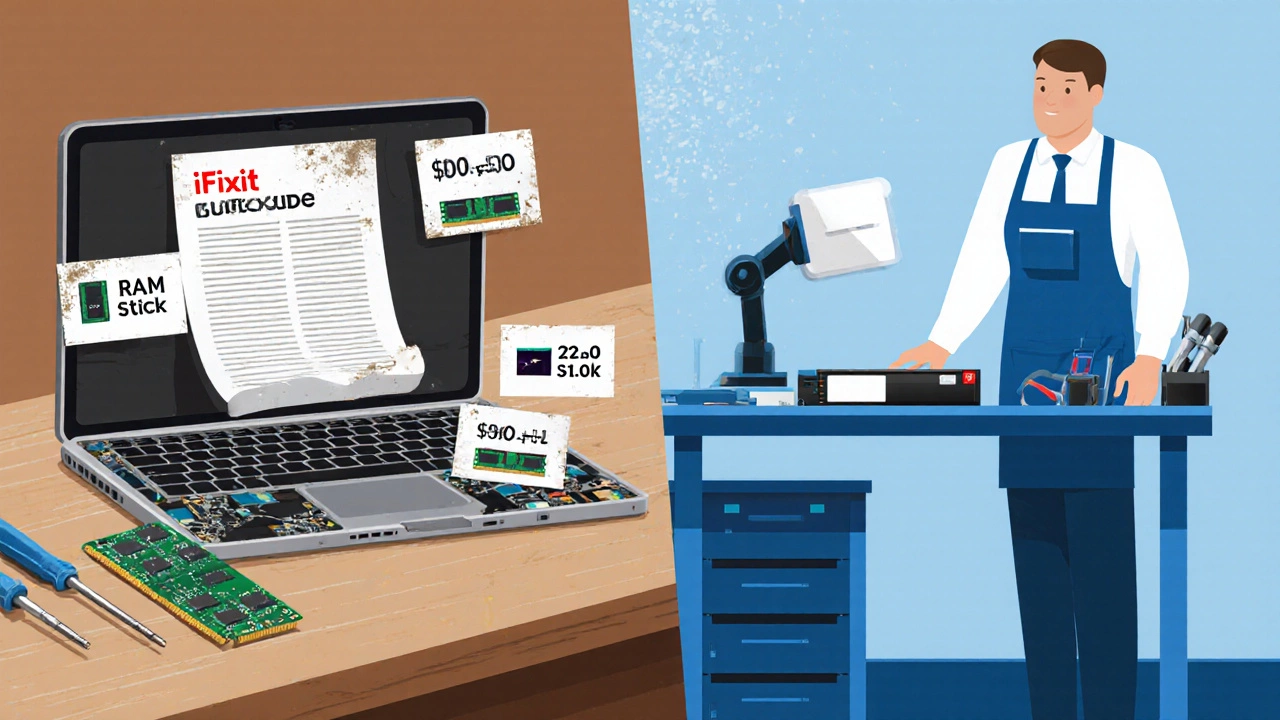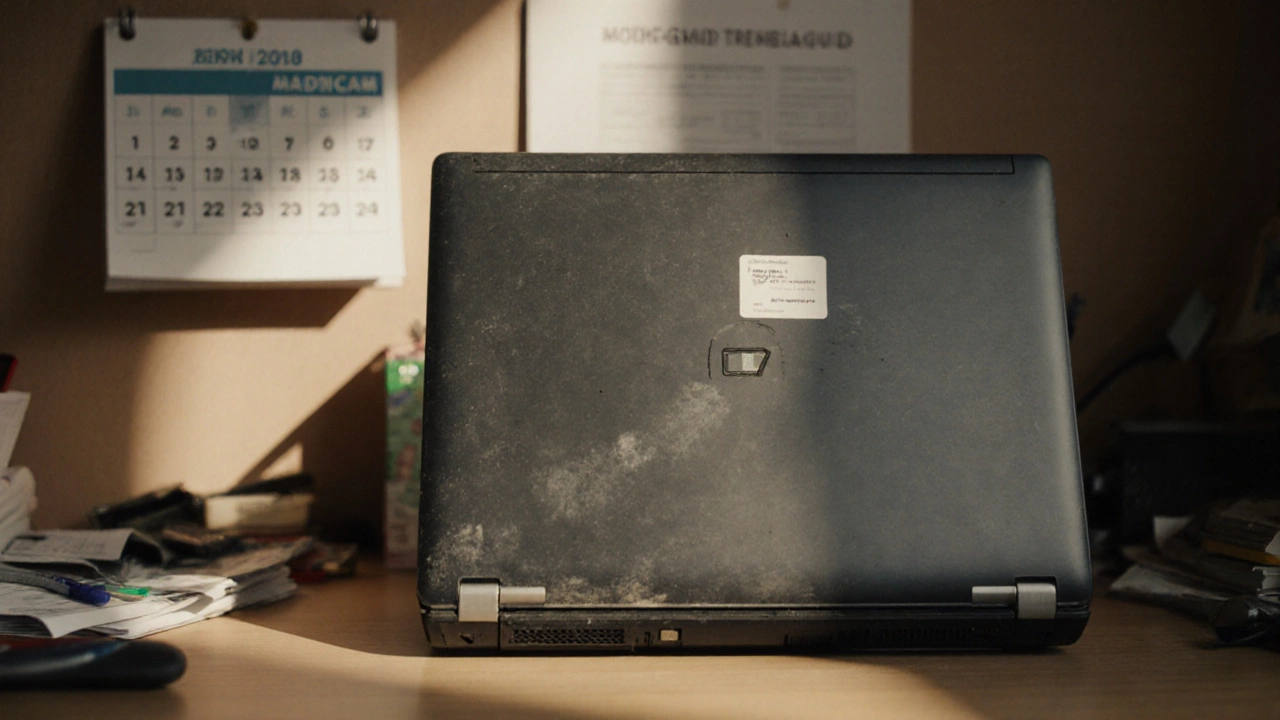Laptop Repair Cost Calculator
Is your repair worth it?
Enter your repair details to see if fixing your 7-year-old laptop makes financial sense.
Results
When your Laptop a portable computer that runs on a battery and an internal processor has been on the desk for seven years, the question “Is it worth fixing a 7‑year‑old laptop?” pops up more often than you think.
Age and hardware wear: what changes after seven years?
Seven years is a long time in tech. The SSD solid‑state storage that replaces traditional hard drives that came with the machine is likely slower than modern NVMe drives, and its flash cells have lost a chunk of write cycles. RAM volatile memory that stores active data for the processor may be limited to 4 GB or 8 GB, restricting multitasking and newer software requirements. The Battery the internal power source that supplies energy when unplugged will have gone through hundreds of charge cycles, often holding barely 30‑40 % of its original capacity.
The CPU the central processing unit that executes instructions may belong to an older Intel Core i5 generation or an AMD equivalent that struggles with today’s parallel workloads. Even the Operating System software that manages hardware resources and provides a platform for applications can be a problem-Windows 7 or an early macOS version often loses security updates.
How much does a repair really cost?
Before you call a Repair Shop a local business that fixes electronics and appliances, get a clear breakdown of parts and labor. Here’s a rough range for common fixes on a seven‑year‑old machine:
- Battery replacement: $30‑$80 for the part plus $20‑$40 labor.
- SSD upgrade: $50‑$120 for a 500 GB drive, $30‑$50 labor.
- RAM upgrade: $25‑$70 for an extra 4 GB stick, $20‑$35 labor.
- Motherboard replacement: $120‑$250 for the board, $80‑$120 labor.
- Screen repair (if it’s a laptop with a cracked display): $80‑$150 part, $70‑$100 labor.
When you add up parts and labor, a typical repair lands between $80 and $300. For a machine that originally cost $600-$800, that’s a 10‑50 % investment.
DIY vs professional repair: which path saves you more?
If you’re comfortable opening a chassis, buying parts online, and following video guides, DIY Repair the practice of fixing devices yourself, using tools and tutorials can shave $30‑$100 off the total cost. Sites like iFixit provide step‑by‑step instructions for battery swaps, SSD installs, and even motherboard replacements.
But DIY isn’t risk‑free. A misplaced screw can damage a delicate connector, and an inexperienced hand might void any remaining warranty (if one exists). Professional shops bring diagnostic tools, spare parts, and experience that can reduce the chance of a second failure. If the laptop has multiple issues-say, a failing battery *and* a broken hinge-splitting the work between you and a shop can become confusing.

When does buying new make more sense?
Use these three quick rules to decide if replacement is smarter than repair:
- Cost‑to‑value ratio: If total repair costs exceed 50 % of the price of a comparable new laptop, replacement wins.
- Performance gap: If the CPU is older than four generations, you’ll notice lag even after a fresh SSD and RAM.
- Future‑proofing: New operating systems, security patches, and software requirements may not run well on legacy hardware.
For most users, a mid‑range new laptop priced at $500‑$700 will outperform a seven‑year‑old unit even after a $250 repair. However, if the laptop is a high‑end workstation (think Dell Precision or MacBook Pro) and you only need a battery swap, fixing can be the cheaper, greener choice.
Environmental and data‑security angles
Electronic waste is a growing problem. The United Nations estimates that the world generated 53.6 million metric tons of e‑waste in 2023. Extending the life of a laptop by even a year keeps it out of landfills and reduces the demand for new raw materials.
On the flip side, old laptops often hold sensitive data. Before you hand it to a repair shop, make sure to wipe the drive securely using tools like DBAN or the built‑in BitLocker erase function. If you plan to sell or donate, reinstall a fresh operating system after backing up your files.

Quick decision checklist
- Is the laptop able to boot into the Windows 10 Microsoft’s current desktop operating system for most PCs or macOS Apple’s desktop operating system for Mac computers?
- What component is failing? (Battery, SSD, RAM, screen, motherboard)
- Get a written quote: part cost + labor.
- Compare the quote to the price of a new laptop with similar specs.
- Consider how long you need the device after repair.
- Factor in environmental impact and data‑security steps.
- Make a choice: repair, DIY, or replace.
Cost comparison table
| Component | Typical Repair Cost (USD) | New Laptop Approx. Cost (USD) |
|---|---|---|
| Battery | $70-$120 | $500-$700 |
| SSD Upgrade (500 GB) | $80-$150 | $500-$700 |
| RAM Upgrade (8 GB) | $45-$105 | $500-$700 |
| Motherboard | $200-$370 | $500-$800 |
| Screen | $150-$250 | $500-$800 |
Bottom line
If the laptop only needs a single, inexpensive part like a battery or SSD, fixing is usually the smarter move-especially if you care about e‑waste. When the repair bill climbs past $250 or the core CPU is ancient, buying a new machine offers better performance and longer support life. Use the checklist, weigh the numbers, and you’ll avoid wasting money on a relic that can’t keep up.
How long can I expect a repaired 7‑year‑old laptop to last?
After replacing the most common wear points (battery, SSD, RAM) a well‑maintained laptop can give you another 2‑3 years of reliable use, provided the CPU and motherboard are still functional.
Is it safe to install a new SSD myself?
Yes. Most laptops have a single access panel for the drive. Just follow a trusted guide, ground yourself to avoid static, and you’ll be done in under 30 minutes.
Will a new battery improve performance?
A fresh battery won’t make the CPU faster, but it will let you stay unplugged longer and prevent sudden shutdowns caused by a weak cell.
What data‑wiping method is best before selling?
Use a full‑disk encryption wipe tool like DBAN for HDDs or the built‑in ‘Reset this PC’ with the “Remove everything and clean the drive” option for SSDs.
Should I upgrade to Windows 11 on a 7‑year‑old laptop?
Only if the CPU meets Microsoft’s minimum specs (generally an 8th‑gen Intel or newer). Otherwise stick with Windows 10, which will receive support until 2025.

I am an expert in the services industry with a focus on appliance repair. My passion lies in understanding how things work and educating others in simple, engaging ways. This enthusiasm fuels my writing, where I delve into topics around appliance maintenance and troubleshooting. I aim to make these subjects clear and accessible to all readers.